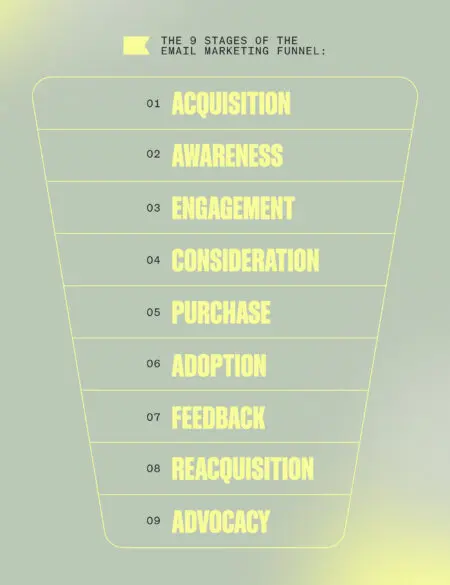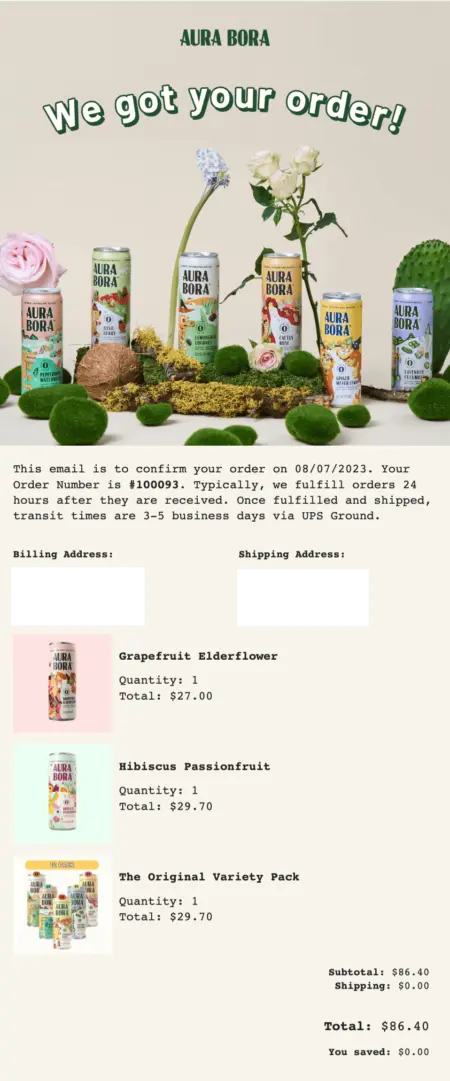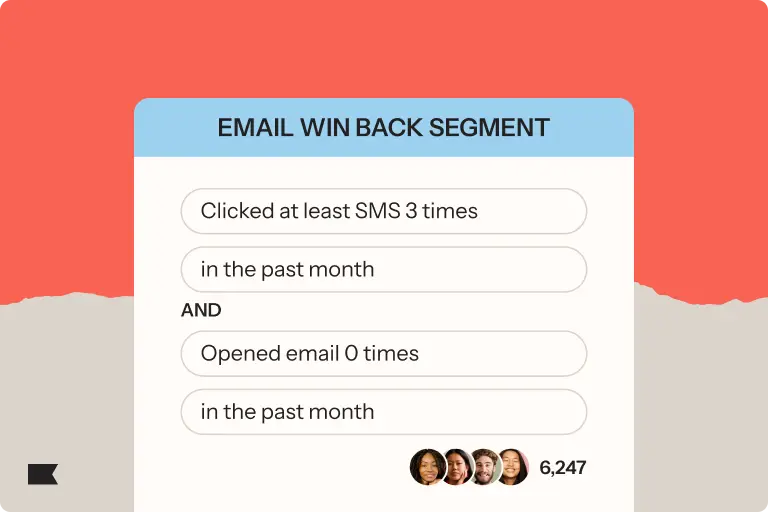How to build your email marketing funnel: a step-by-step guide to repeat purchases
Let’s get the bad news out of the way first…
Consumer expectations have shifted and there’s no single type of funnel that’s going to convert everyone. What really works is creating personalized experiences that focus on the micro-moments within the shopper’s journey and using those to influence and capture the customer––again, and again, and again.
This is what retention marketing focuses on, and some experts have suggested that it be renamed to “re-acquisition” to highlight just how important it really is in today’s market.
As Grace Clarke, an ecommerce marketing consultant, pointed out during the OWN IT conference, “brands are shifting from the thought process of ‘Once we have a customer, we have them forever,’ to ‘Once we have a customer, we get to continue to stay in a relationship with them and reacquire.’”
So, how do you do that?
How do you create micro-moments and personalized experiences that build customer loyalty and repeat purchases––ultimately impacting every customer’s lifetime value? Moreover, how do you do that without running your marketing and customer service teams into the ground?
Well, you build a powerful email marketing funnel that uses segmentation to scale personalization. That might sound like a mouthful, but the act of building it is relatively simple with Klaviyo.
The exponential—and cost effective—power of a strong email marketing funnel
A properly planned and executed email marketing funnel creates a personalized customer journey that leads to a positive brand experience and maximizes ROI. With the right CRM, you’ve got easy access to accurate data that allows you to address whatever concern the subscriber is experiencing at that point in the funnel—and avoid overwhelming them with irrelevant information.
Remember: messages you send out via email have no added cost on top of what you’ve already invested in your creative team and your email service provider. An email marketing funnel is cost-effective—over 75% of all businesses place email marketing in the top 3 ROI-generating marketing channels, according to Klaviyo’s 2023 marketing mix report.
How to maximize each of the 9 stages of the email marketing funnel
The 9 key stages of the email marketing funnel are acquisition, awareness, engagement, consideration, purchase, adoption, feedback, reacquisition, and advocacy. We’ve got a deep dive into the importance of each stage and its impact on the customer journey.

1. Collect addresses and grow your email list
The top of the funnel involves collecting subscribers you can then nurture.
“The whole relationship starts with the pop-up,” Milo McMahon, founder and lead strategist at Outdoor Ecommerce, says.
The whole relationship starts with the pop-up.
It’s true: One of the best parts about email marketing is that your subscribers want to hear from you. Your emails are welcome in their inbox, as opposed to paid ads popping onto their screens or interrupting them while scrolling through social media.
To build that relationship, you’ll need them to opt in to your marketing emails. The best way to do this is via an opt-in form on your website.
McMahon offers some advice about timing, too: “Give your website visitors time to investigate your product and brand before you ask them for their email address.”
He recommends waiting at least 8-10 seconds before showing the email pop-up, but he also suggests split testing. “See what happens when you wait longer,” he says. “You may get fewer total sign-ups, but you also may be getting a higher quality audience who have more intent, because you gave them time to learn about your products before you got them on your list.�”
You can also use sign-up forms to collect more than just contact information.
Answers are a goldmine of direct inputs from customers—the zero-party data we collect syncs as profile properties within Klaviyo, creating the bridge to facilitate personalized interactions with our customers.
Jones Road Beauty, for example, offers an onsite quiz that helps customers find their perfect shade of foundation, concealer, tinted face powder, and other products. “These answers are a goldmine of direct inputs from customers—the zero-party data we collect syncs as profile properties within Klaviyo, creating the bridge to facilitate personalized interactions with our customers,” Joanne Coffey, retention marketing manager at Jones Road Beauty, explains.
And the end results are significant: Jones Road Beauty’s placed order rate is 20% higher if a customer fills out the quiz, as opposed to a standard welcome flow.
2. Build awareness by nurturing your subscribers
Your new subscribers probably know the gist of what you sell, but your early emails to them should communicate the best of what you offer. The last thing you want is for potential customers to unsubscribe because they don’t know you can solve their problems.
This is the awareness stage.
A welcome series is a great way to capitalize on the new interest in your brand. And it has the power to convert subscribers into customers: Welcome email flows across industries drove $2.40 in revenue per recipient in Q2 2023, according to Klaviyo benchmarks.
Your welcome series is the beginning of your email funnel!
— Email Marketing Strategist for Service Providers (@chelseacarterco) June 5, 2022
Not only is it a way to introduce yourself to you new community members, it’s the starting point for putting your email marketing on autopilot!
Image source: Twitter/X
Tabish Bhimani, director and principal strategist at Mastrat Digital recommends always including a discount in your welcome email—no exceptions. He says this does much more than encourage that first purchase. It can:
- Create the habit-forming behavior of opening your brand’s emails
- Reward the customer for signing up
- Give your brand an opportunity to capture zero-party data (if you include a survey in the email with the discount)
- Have a positive impact on your deliverability
Ecreamery, an omnichannel ice cream brand, sends this email soon after a visitor subscribes. It does a few things to build awareness of what the brand can do for their customers:
- Leads with a free, enticing offer
- Highlights seasonally available flavors—a move that may motivate a quicker purchase before stock runs out
- Includes an easy-to-navigate menu at the bottom that shows how shoppers can easily customize gifts and set up a subscription

Image source: Ecreamery
Consider these pro tips to nurture your subscribers via a welcome email:
- Segment your welcome series based on where you collected the subscriber’s email address. For instance, if they signed up for emails in-store, send them coupons they can use there.
- Personalize your emails by using the subscriber’s first name in the subject line or first line of the email, or displaying products they’ve browsed in the past.
- Make sure the email design is optimized for conversion, with high-quality product shots, on-brand headlines and copy, and CTA buttons above the fold.
3. Drive engagement by sharing your brand mission
At the engagement stage of the email marketing funnel, you’re showing your subscribers how you can solve their pain points. At this point, it’s crucial for your brand story and mission to be crystal clear, so you can communicate it to your readers.
Skincare brand KORA Organics sends this email that goes into quite a bit of detail about topics they know their audience cares about: that the products are certified organic and highly effective.
At the very bottom, 6 icons communicate important points, concisely anticipating potential sales objections and resolving them.

Image source: KORA Organics
Consider these pro tips to engage your subscribers:
- Get clear on your company’s mission and vision so you can communicate it clearly and creatively.
- Get in-depth about what your audience cares about—in this case, the fact that the products are both organic and effective.
- Don’t be afraid to communicate with visuals. Part of the reason KORA is able to get so much into this email is that
4. Encourage consideration by differentiating your brand
Once you’ve communicated your brand values and what you can deliver to your potential customers, you’ve entered the consideration stage. At this point, you need to differentiate yourself from your competitors to help get the consumer to the all important conversion stage.
“At this stage of the email marketing funnel, your brand is stacking up value as to why a subscriber should consider buying from you,” explains McMahon.
At this stage of the email marketing funnel, your brand is stacking up value as to why a subscriber should consider buying from you.
Take a look at this example from Bookshop, an alternative to Amazon whose tagline is “Every Purchase Supports Independent Bookstores. A Better Way to Buy Books Online.”
The first sentence strikes an inclusive note, assuming that the subscriber is already a supporter. The email also shares how much money the company has generated for local, independent bookstores—a cause most visitors to Bookshop.org care about. They include a small discount, and then, more importantly, they reiterate what their company does and how the subscriber can help them achieve their mission.
This email also includes a link to the recipient’s subscription preferences page, the company’s entire mission statement, and a geo-locator to help readers find their local bookstore.

Image source: Bookshop
Pro tip: Don’t be afraid to explicitly differentiate your brand from competitors, even if you don’t mention them by name. Bookshop’s mission seems to have developed in response to Amazon’s growth and domination. And that’s a big reason why people like to give their money to Bookshop. The brand doesn’t shy away from this as they introduce themselves to their new friends at this stage of the funnel.
5. Keep building trust throughout the purchase experience
Congratulations—your efforts at awareness, engagement, and consideration were successful, and your subscriber has bought at least one product from you.
Now what? Sit back and hope they like it? Not quite.
Once a subscriber has reached the conversion stage and made a purchase, they’re officially through the narrow part of the funnel. This period is crucial for building trust. Bhimani sees the post-purchase phase as a time to “drive the confidence factor up.”
“Once someone pays you,” he says, “your job is to focus on stewardship. Communicate, communicate, communicate. Be available on as many channels as possible.”
Once someone pays you, your job is to focus on stewardship. Communicate, communicate communicate. Be available on as many channels as possible.
Herbal water brand Aura Bora sends purchase confirmation emails packed with plenty of information:
- The date of the purchase
- The order number
- How many hours it typically takes the team to fulfill orders
- Typical transit time frames
- Which shipping carrier they use
- The customer’s billing and shipping addresses
- Exactly which products the customer ordered, how many of each, and how much they cost
- The customer’s total bill
- How much money they saved (if any)
This is a lot of detail, and Aura Bora presents it in an intuitive, easy-to-digest, and beautiful design. The customer doesn’t have to do any digging if they want to make sure their shipping address is correct, for instance, or they want to balance that month’s budget and get an exact figure of what they spent.

Image source: Aura Bora
Pro tip: Don’t be afraid to go beyond transactional emails and set up more detailed post-purchase emails—they’re a great place to keep building trust.
6. Encourage adoption by continuing to educate
Once your subscriber has converted into a customer, it’s a great time for (more) education. The adoption phase is when you should provide onboarding tools like tutorials that will set your new customer up to get the most out of your products.
Emails at the adoption phase can feature everything from user-generated content showing how the product looks IRL, to reviews hyping a particular product, to video content teaching customers how to best use the product.
After someone makes their first purchase, Jones Road Beauty, for example, sends specific post-purchase product education during the adoption phase, along with a personal follow-up from a member of the customer experience team.
This simple tutorial doesn’t require the customer to leave the email—unless they want to buy more:

Image source: Jones Road Beauty
Pro tip: Invest in creating educational content such as product tutorials, how-tos, and guides. You can use them across mediums to create true value for your audience, and have a reason to talk to them that isn’t salesy.
7. Prevent churn by starting conversations and communicating frequently
One way to keep your customers coming back is to ask them what’s working—and what’s not—about your products.
Coffey offers a straightforward strategy to prevent churn—reaching out with genuine concern. Jones Road Beauty, known for its superb customer support, shares a page from their playbook: Churn risks enter into a flow to receive text-based emails from either the chief marketing officer or the senior director of customer experience, asking what would improve the experience.
These emails steer clear of sales pitches, instead expressing a genuine willingness to hear concerns and enhance the experience with Jones Road Beauty.
Communicating regularly and clearly is a great way to strengthen a relationship, especially when you aren’t pushing a sale.
You can do that by:
- Automating transactional emails like confirmation and post-purchase
- Communicating shipping delays clearly
- Automating cross-sell emails
- Sharing your loyalty program
- Requesting reviews and rewarding shoppers for writing them
- Setting up a solution to initiate returns and exchanges
- Ensuring a robust customer support program is in place
Jewelry brand Uncommon James sends this request for reviews a few weeks after a customer receives their products. It includes several questions about the shopper’s experience with their new jewelry, and each one is easy to answer, setting the shopper up to feel heard, understood, and cared about.
The email also asks a few questions related to the shopper’s demographics, which can help the brand personalize future emails.

Image source: Uncommon James
How can you make the most of the reviews customers write? The Jones Road Beauty team, for instance, reads their 1-2 star reviews carefully and uses the feedback to head off objections in future educational emails.
Bhimani emphasizes the importance of timing with emails that ask for product feedback. Of course, you don’t want them to arrive before the products do. “With the right tech stack,” he says, “you can trigger flows once a product is delivered.”
Pro tip: Bhimani advocates for collecting SMS numbers during check-out, so you can offer SMS support for orders.
8. Keep your eye on expansion—you can do more than up- and cross-sell
If you have 1-2 products that have solved a pain point for your customers, chances are, you can provide them with even more value through other products.
Once a subscriber has converted and made a purchase, Jones Road Beauty invites them to join a VIP Facebook group with over 25K customers. There, they get early access to product launches, have open conversations about confidence, and learn from the brand’s trained team of makeup artists.
It’s a thoughtful, creative way to create community around your brand and the things that matter to your customers.
There are plenty of other ways to introduce your other products to your existing customers: personalized emails based on what they’ve bought, browse abandonment flows, or simple cross-sell emails.
Or, you can make a BOGO free offer, like Aura Bora does in this email. This not only encourages already-loyal customers to try a new product, it also helps the brand sell more cases in stores.

Image source: Aura Bora
Pro tip: Don’t be shy. At this point in the funnel, your customers like you. So don’t hesitate to introduce them to a new product, or even incentivize them to try it.
9. Encourage advocacy with incentives
Once someone has bought your products more than once, that means you’re doing something right. It’s time to see if they’re willing to advocate to others on your behalf. If you haven’t already sent a review request, now is the time.
And why not take it a step further? There is no better marketing than someone you know recommending a product or brand. So why not incentivize that word-of-mouth recommendation?
Toilet paper brand Who Gives A Crap sends this silly, simple email offering a discount to refer them.

Image source: Who Gives A Crap
An incentivized referral isn’t the only way to encourage advocacy. You can also reward customers for referring you by granting more loyalty points. Or you can share a hashtag and encourage shoppers to share how they use your product on their social channels.
Pro tip: Consider regular customers prime for referrals and get creative about how you nurture and reward them.
How personalization and automation power a more effective email marketing funnel
If you haven’t already started to automate your email marketing funnel, now’s the time. As the industry reorients around AI, tools like Klaviyo’s Smart Sending and Smart Send Time set you up to never email any one customer too often and to understand the best windows for your customers to receive emails.
When you pair that with our advanced personalization, the customer experience is elevated and the results speak for themselves.
“Personalization, to us, extends beyond utilizing the ‘First Name’ tag,” Coffey says. “It encapsulates a tailored approach where every message is adapted based on the customer’s actions during their browsing session.”
“Our strategy is a multi-step approach to guide them through the buyer’s journey, including education, positive reviews, driving to quizzes, and asking if they need any assistance—rather than just pushing a sale,” she adds. “This strategy has increased our place order rate by 315%.”
Email marketing funnel FAQs
Some commonly asked questions about email marketing funnels.
What is an email marketing funnel?
An email marketing funnel refers to the process by which a subscriber goes from a prospective lead to a customer through emails that are both educational and promotional.
How often should I send emails in my funnel?
The cadence of your email sends will depend on the actions you choose for your subscribers to trigger them, as well as your brand’s prerogative. We recommend that you time your email sends based on how engaged your audience is. For instance, send to highly engaged subscribers daily, send to people who haven’t opened or clicked in the last 30 days 3x a week, send just 1x a week to people who haven’t opened or clicked in the last 90 days.
How do I measure the success of my email marketing funnel?
A good customer data platform like Klaviyo will have analytics that show you how successful your marketing emails are according to key performance indicators like open rate, click rate, conversion rate, and revenue per recipient. You can also measure your results against our benchmarks and filter by industry.
What are some best practices for automating email marketing funnels?
Some best practices for automating email marketing funnels are:
1. Enable sign-up forms on your website to gather email subscribers and new leads.
2. Collect zero-party and first-party data about your customers so you can personalize your email marketing campaigns.
3. Segment your customers so you can send more relevant emails.
4. Nurture your subscribers through email sequences with welcome series, educational content, and brand stories.
5. Build trust throughout the funnel with transactional emails, requests for reviews, and invitations to loyalty programs.

Related content

Discover the best email marketing platform for ecommerce in 2026. Compare top tools for data, automation, personalization, and deliverability.

Learn how to use Klaviyo SMS, segmentation, and hybrid flows to re-engage lapsed email subscribers, boost deliverability, and drive higher retention.

Boost D2C email revenue from 12% to 30% with the Klaviyo playbook: high-converting pop-ups, a 5-email welcome series, smart filters, and optimized abandonment flows.